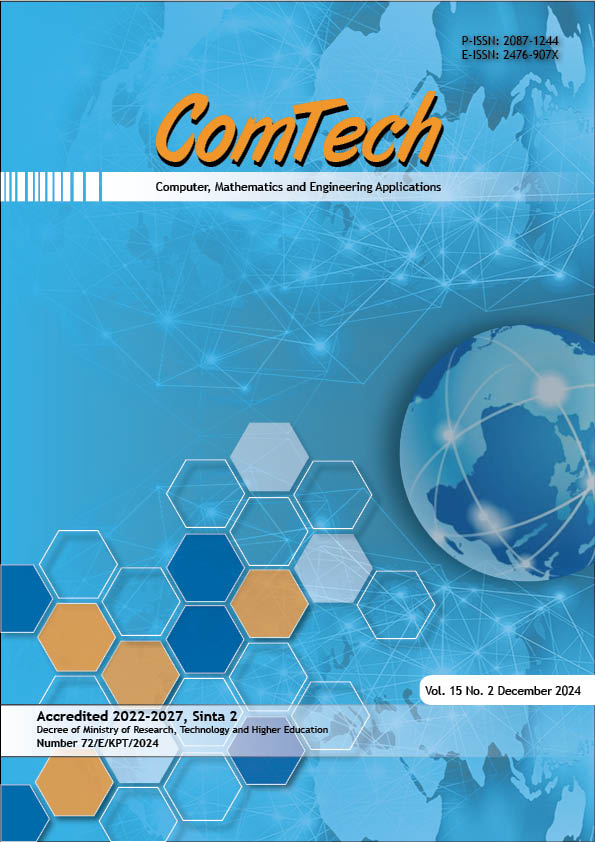Implementation of Clustering and Association for Early Warning of Disasters in Bojonegoro Regency
DOI:
https://doi.org/10.21512/comtech.v15i2.11933Keywords:
clustering and association, cearly warning, disasters, Bojonegoro RegencyAbstract
The research aimed to analyze the relationships between different types of disasters, assess the likelihood of disaster occurrences, and enhance knowledge and understanding of disaster patterns in Bojonegoro Regency. The goal was to enable better disaster prediction and preparedness in the future. The methods applied included mapping, clustering using the K-means algorithm, and association rule mining with the Apriori algorithm. Secondary data were obtained from the National Disaster Management Agency and the Bojonegoro Regency Regional Disaster Management Agency Office, covering eight types of disasters. The results reveal that the K-means model groups the data into 5 clusters from 28 sub-districts in Bojonegoro. There are 13 sub-districts in Cluster 0, 1 sub-district in Cluster 1, 4 sub-districts in Cluster 2, 6 sub-districts in Cluster 3, and 4 sub-districts in Cluster 4. The association rule analysis produces four association rules using a minimum support of 10% and a minimum confidence of 50%. The findings highlight that the Ngasem and Bojonegoro sub-districts require more focused disaster management. The fourth association rule has the highest confidence level at 78.79%, indicating that forest and land fires are likely to follow when drought occurs. The research implies that it can support more targeted disaster management focusing on high-risk sub-districts such as Ngasem and Bojonegoro. The originality of the research lies in its novel application of clustering and association rules to analyze disaster patterns in the region, with implications for more targeted disaster mitigation strategies.
References
Aggarwal, C. C. (2015). Data classification. In Data mining (pp. 285–344). Springer. https://doi.org/10.1007/978-3-319-14142-8_10
Ahmed, M. A., Mohamed, M. H., Parvin, M. M., & Ilić, P. (2022). The recurrence of natural disasters in Jowhar, Middle Shabelle Region, Somalia: The causes and impacts. Journal of Environmental Protection, 13(9), 657–670. https://doi.org/10.4236/jep.2022.139042
Alawadh, M. M., & Barnawi, A. M. (2022). A survey on methods and applications of intelligent market basket analysis based on association rule. Journal on Big Data, 4(1), 1–25. https://doi.org/10.32604/jbd.2022.021744
Das, A., Jana, S., Ganguly, P., & Chakraborty, N. (2021). Application of association rule: Apriori algorithm in e-commerce. In 2021 Innovations in Energy Management and Renewable Resources (pp. 1–7). IEEE. https://doi.org/10.1109/IEMRE52042.2021.9386737
Furuse, Y., Sando, E., Tsuchiya, N., Miyahara, R., Yasuda, I., Ko, Y. K., ... & Oshitani, H. (2020). Clusters of coronavirus disease in communities, Japan, January–April 2020. Emerging Infectious Diseases, 26(9), 2176–2179. https://doi.org/10.3201/eid2609.202272
Gupta, M. K., & Chandra, P. (2020). A comprehensive survey of data mining. International Journal of Information Technology, 12, 1243–1257. https://doi.org/10.1007/s41870-020-00427-7
Morganstein, J. C., & Ursano, R. J. (2020). Ecological disasters and mental health: Causes, consequences, and interventions. Frontiers in Psychiatry, 11, 1–15. https://doi.org/10.3389/fpsyt.2020.00001
Murdiaty, Angela, & Sylvia, C. (2020). Pengelompokkan data bencana alam berdasarkan wilayah, waktu, jumlah korban dan kerusakan fasilitas dengan algoritma K-Means. Jurnal Media Informatika Budidarma, 4(3), 744–752. https://doi.org/10.30865/mib.v4i3.2213
Nurdiansyah, D., Ma’ady, M. N. P., Sukmawaty, Y., Utomo, M. C. C., & Mutiani, T. (2024). Clustering analysis for grouping sub-districts in Bojonegoro District with the K-Means method with a variety of approaches. BAREKENG: Journal of Mathematics and Its Application, 18(2), 1095–1104. https://doi.org/10.30598/barekengvol18iss2pp1095-1104
Nurdiansyah, D., Saidah, S., & Cahyani, N. (2023). Data mining study for grouping elementary schools in Bojonegoro Regency based on capacity and educational facilities. BAREKENG: Journal of Mathematics and Its Applications, 17(2), 1081–1092. https://doi.org/10.30598/barekengvol17iss2pp1081-1092
Prasetyadi, A., Nugroho, B., & Tohari, A. (2022). A hybrid K-Means hierarchical algorithm for natural disaster mitigation clustering. Journal of Information and Communication Technology, 21(2), 175–200. https://doi.org/10.32890/jict2022.21.2.2
Riasetiawan, M., Ashari, A., & Wahyu, P. (2022). The performance evaluation of K-Means and agglomerative hierarchical clustering for rainfall patterns and modelling. In 2022 6th International Conference on Information Technology, Information Systems and Electrical Engineering (ICITISEE) (pp. 431–436). https://doi.org/10.1109/ICITISEE57756.2022.10057729
Sholikhah, N. A. (2022). Studi perbandingan clustering kecamatan di Kabupaten Bojonegoro berdasarkan keaktifan penduduk dalam kepemilikan dokumen kependudukan. Jurnal Statistika dan Komputasi, 1(1), 42–53. https://doi.org/10.32665/statkom.v1i1.443
Udori, A., & Miranti. (2019). Upaya Badan Penanggulangan Bencana Daerah (BPBD) dalam penanggulangan bencana banjir. Jurnal Politik dan Pemerintahan Daerah, 1(2), 85–94. https://doi.org/10.36355/jppd.v1i2.8
Wu, Y., & Zhang, J. (2023). Retraction note: Building the electronic evidence analysis model based on association rule mining and FP-growth algorithm. Soft Computing, 27. https://doi.org/10.1007/s00500-022-07709-1
Downloads
Published
How to Cite
Issue
Section
License
Copyright (c) 2024 Denny Nurdiansyah, Erna Hayati, Ika Purnamasari, Anna Apriana Hidayanti, Yuliana Fuji Rahayu

This work is licensed under a Creative Commons Attribution-ShareAlike 4.0 International License.
Authors who publish with this journal agree to the following terms:
a. Authors retain copyright and grant the journal right of first publication with the work simultaneously licensed under a Creative Commons Attribution License - Share Alike that allows others to share the work with an acknowledgment of the work's authorship and initial publication in this journal.
b. Authors are able to enter into separate, additional contractual arrangements for the non-exclusive distribution of the journal's published version of the work (e.g., post it to an institutional repository or publish it in a book), with an acknowledgment of its initial publication in this journal.
c. Authors are permitted and encouraged to post their work online (e.g., in institutional repositories or on their website) prior to and during the submission process, as it can lead to productive exchanges, as well as earlier and greater citation of published work.
 USER RIGHTS
 All articles published Open Access will be immediately and permanently free for everyone to read and download. We are continuously working with our author communities to select the best choice of license options, currently being defined for this journal as follows:




















